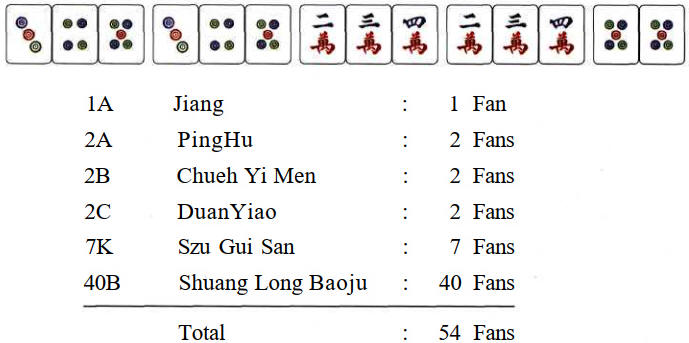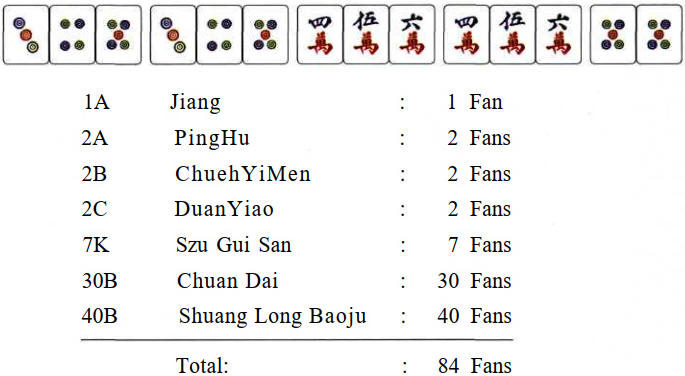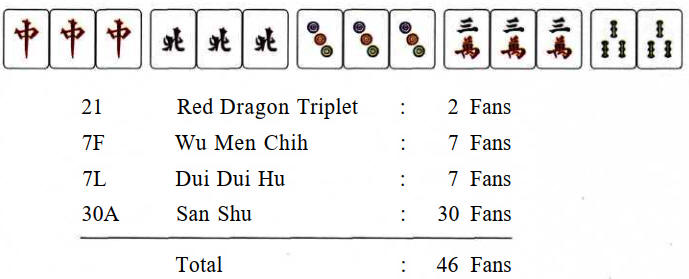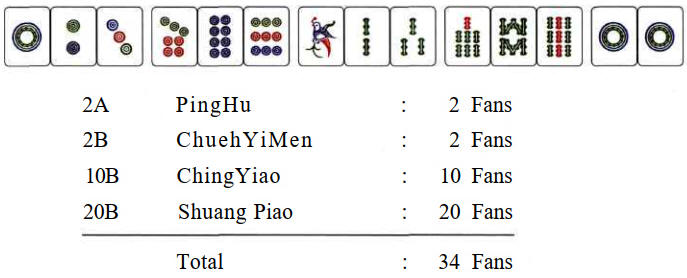
The Shanghai Game
Jeux
Mah-Jongg
The Shanghai Game, also known as the New Rules Game, is a variation from the Old Rules, or Cantonese Game.
The playing of the game is basically the same as the Cantonese Game, but some of the rituals and procedures, such as designating the seating, choosing the First Dealer, building the walls, discarding the tiles, displaying a revealed Sequence, the Fortune Hand, and the matching of the revealed 13-Terminal Tile Hand, are slightly different.
The scoring of the Shanghai Game differs substantially from that of the Cantonese Game, in that the former has a much greater variation in the combination of tiles and sets in a winning hand.
Certain terminologies are different, too, and the terms are pronounced in Mandarin Chinese, instead of in Cantonese. Due to the complexity of its scoring, the Shanghai Game is not recommended for beginners.
In this chapter, the author assumes that the reader is already familiar with certain basic procedures, such as claiming a tile to match a Sequence or a Triplet, and the general courtesies that must be observed during the game.
Terminology
There are some slight differences in terminology between the Shanghai Game and the Cantonese Game:
| Cantonese | Shanghai | |
|
(1) Claiming a
tile to match a Sequence: (2) Claiming a tile to match a Triplet: (3) Claiming a tile for a Quadruplet: (4) Claiming a tile to win: |
Sheung Pung Gong Sik |
Chuh Peng Garng Hu |
Designating the Chair of the First
Dealer Once the four players have seated themselves randomly around a square table, any player may cast two or three dice, and the dots are summed.
The dice caster begins to count counterclockwise with his or her seat counted as 1, the next seat as 2, and so forth, until the sum is reached.
The seat at the end of the count is the chair of the First Dealer.
Example:
If the player at Side A of the table casts the dice and the sum of the dots is two, then Side B is the chair of the First Dealer and is also the East chair of the first round.

Choosing the First Dealer
Just as in the Cantonese Game, one each of the four Wind tiles is used for choosing the First Dealer. Unlike the Cantonese Game, the four Wind tiles are mixed well and placed face down in a row on the table. Furthermore, a No. 1 tile is placed face up on the left end of the row, and a No. 2 tile is placed, face up on the right end.
Then the same player casts the dice again to determine who will pick up the first Wind tile in the row.
If the sum of the dots on the cast dice is an odd number, the player at the end of the count picks up the first Wind tile from the end having the No. 1 tile. If the sum is an even number, then the first Wind tile is picked up from the opposite end.
The Lower House of the first Wind tile picker then picks up the second Wind tile and so forth.

Example: If the sum of the dots on the cast dice is three (an odd number),
the player at side C picks up the first Wind tile from the end that has the No.
1 tile.
If the sum of the dots on the cast dice is two (an even number),
the player at side B picks up the first Wind tile from the end that has the No.
2 tile.


After four Wind tiles have been picked up, the player who holds the East Wind tile is designated as the First Dealer, and he or she is seated at the East Chair, as designated by the previous cast of the dice.
The player who holds the South Wind tile is seated to the right of the East chair.
The players who hold the West Wind tile and the North Wind tile will be seated, respectively opposite the East side and to the left of the East side.

In the Shanghai Game, after the first four rounds of the game have been completed, the players do not have to undergo the same long procedure of choosing and designating the seating all over again.
Instead, they merely exchange seats: East with South and North with West.
The last winner of the fourth round will be the First Dealer of the next four rounds. But after eight rounds are completed, the process of seat selection is carried out as a new round.

Building the Walls (De Pai)
For the Shanghai Game, the walls of tiles are arranged in two single rows of 17 tiles each. These rows are placed in contact with each other, instead of being stacked up, in the style of the Cantonese Game.
In the Shanghai Game, the row that is located near the table center is equivalent to the upper row of the double stack
in the Cantonese Game. Usually, a set of four rulers, each having a length equal to 18 tiles, is provided for each player to align the tiles when building the walls.
One of the rulers is engraved with the First Dealer's ensign. This ruler should be used by the First Dealer for identification. The rulers are also used by the players during the game to keep the playing-hand tiles tidy.

Discards (Chu Pai)
Discarded tiles should be arranged in rows in an orderly fashion inside the walls in front of each player.

Displaying Revealed
Sequences When a player claims a discard to make a Sequence, he or she reveals the 2 matched tiles face up and side by side on the table.
The player then places the claimed tile in contact with both of the 2 revealed matched tiles, away from him- or herself, in a horizontal position. By doing so, the claimed discard can be identified.

Fortune Hand (Wang Zhuang)
All of the tiles on the walls are available for drawing to complete the game. If there is no winner as the last tile is drawn and a discard is made, a Fortune Hand has been played, since there is no loser in the hand.
With the Shanghai Game, the dealership is passed on to the next player. This is different from the Cantonese Game, in which the dealership is passed on to the next player only when there is a winner.
Assembling a Revealed 13-Terminal Tile Hand (Wai Shuh San Yiao)
In the Shanghai Game, a player is also allowed to assemble on the table a 13-Terminal Tile Hand with his discards while still reserving the right of matching a concealed hand.
Unlike the 13-Terminal Tile Hand that is assembled, unrevealed, in a playing hand, this "revealed" 13-Terminal Tile Hand is made by continuously discarding one each of the 13-Terminal tiles and Honor tiles without interruption.
These discarded tiles are displayed in a row inside the wall in front of the player.
Note: The discarding of Terminal tiles cannot be interrupted by discarding a non-Terminal tile or by claiming a discard from another player.
If another player claims any of the discarded Terminal or Honor tiles (other than to declare a win) in this "revealed" 13-Terminal Tile Hand in the making, those claimed discards will still be counted as part of the 13 Terminal tiles needed for completing the hand.
Of course, the player must keep track of which Terminal tiles were claimed by whom, so that those claimed tiles can be reclaimed to complete a winning hand. The winner of the 13-Terminal Tile Hand has first priority to claim a Winning Tile regardless of which player discards it.

Scoring (Suan Fan)
Scoring in the Shanghai Game is quite different from the Cantonese Game. For instance, the lowest score (the minimum hand) and the highest score (the limited hand) are usually set by the players before starting each game.
In general, the minimum hand is set at 5 Fans, while the limiting hand is 100 Fans (Fung Men) or 200 Fans (Shuang Fung Men).
Beginners may find it more desirable to lower the minimum hand to 3 Fans for an easier win and to make learning the game more interesting.
ONE FAN 1A Jiang - Special Eyes
Eyes composed of No. 2, No. 5, or No. 8 tiles of any suit.

TWO FANS
2A Ping Hu All Sequences Hand
A
winning hand consisting only of Sequences in more than one suit.

2B Chueh Yi Men - Absence of One Suit
A winning hand consisting
of Sequences and Triplets in two suits, with or without the Honor tiles.

2C Duan Yiao - Absence of Terminal Tiles
A winning hand that
does not contain any No. 1, or No. 9 tiles or an Honor tile.

2D Yi Ban Gao Two Identical Sequences
A winning hand
consisting of two identical Sequences.

2E Men Ghien Ching - Without Revealed Sets
A winning hand completed without claiming any discard (claiming a discard for a Quadruplet is not considered claiming a discard in this case).
2F Duh Ting - One Way to Win
Only one number can be the Winning Tile.

2G Garng Following a Garng The Winning
Tile is the make-up tile following a Garng.
2H Fung Honor Tiles
A Triplet of Dragon, Round Wind, or House Wind tiles.

2I Ching Szu Peng - Four Revealed Triplets
A winning hand with four revealed Triplets.
2J Lao Shao Young and Old Sequences
A winning hand containing one Sequence of No. 1, No. 2, and No. 3, and another Sequence of No. 7, No. 8, and No. 9, both of the same suit.

2K Kan Shin Wu - Bridge Tile
When the Winning Tile is the No. 5 tile, which completes a Sequence, together with the No. 4 and No. 6 tiles, in any suit (Kan Shin Wu and Duh Ting (2F) is four Fans).

THREE FANS
3A Lao Shao Peng - Young and Old Triplets
A winning hand containing one Triplet of No. 1 and another Triplet of No. 9 tiles of the same suit.

3B Liang Garng Two Quadruplets
A winning hand containing two Quadruplets of any suit.

3C Chiang Garng - Robbing a Garng
Claiming the Winning Tile from another player who declares a Garng, at the time he or she adds the fourth identical tile to a revealed Triplet.
3D Hai Dee - Last Tile Drawn
A self-drawn Winning Tile that is the last one on the walls.
3E Hai Di Chong Last Tile Drawn and Discarded
The Winning
Tile is the last tile drawn from the walls and immediately discarded by another
player.
3F Jueh Jarng - One Tile to Win
When only one
number can win and the Winning Tile is the final tile of that number, as three
out of four of the same number have already been discarded and therefore
revealed.
3G Szu Gui Er Four into Two
Four tiles of the
same number tiles included in two sets, a Sequence and a Triplet.

3H Wei Wei - A Tail
Two triplets plus one
pair in consecutive numbers of the same suit, or two
sets and one pair of any
Wind tiles.

FIVE FANS
5A Men Ching Buh Chiu -
Totally Self-Sufficient
An All Concealed Hand,
achieved without claiming any discard and the Winning Tile is self-drawn.
Note: Quadruplets are counted as a concealed set.
SEVEN FANS
7A Yi Tiao Long One
Dragon Suit
A complete set of numbers, from one to nine, of any
one suit.
7B San Xiang Fung - Encounter of Three (also called
Jieh May Hua)
Three Sequences of the same numbers but in all three
suits.

7C Huen Dai Yiao Mixed
Terminal Sequences and Honor Tiles
A winning hand with Honor
tiles and Sequences (each of which contains a Terminal tile). The Eyes are
either composed of Terminal tiles or Honor tiles.

7D Barn Chiu Ren - Semi Self-Sufficient
A winning hand with four
revealed sets and the Winning Tile is self-drawn.
7E Bao Ting Announcing a
Ready Hand
At the initial drawing of the 13 tiles, and before
drawing and claiming any tile, a player announces that he or she has a Ready
Hand and is waiting for the Winning Tile.
Note: After the announcement, a player cannot
exchange any tile in his or her hand with any drawn tile or discard. Failing to
do so will forfeit the status of Bao Ting.
7F Wu Men Chih - All
Categories
A winning hand consisting of all three suits, Wind,
and Dragon tiles.

7G Shuang Jueh Jarng - Double Jeopardy
The Winning Tile is the
last one of the eight tiles.
Example: The last set you need to complete is composed of No. 2 and No. 3 Circle tiles, and you are waiting either for a No. 1 or No. 4 to win.
But all of the No. 1 Circle tiles and three of the four No. 4 tiles have been discarded or revealed.
7H San An Kan - Three
Concealed Triplets
A winning hand with three concealed Triplets. Note: A
Quadruplet is counted as a concealed Triplet.
7I Huen Yi Sher - Mixed One
Suit

A Mixed One-Suit Hand, which
consists of only one suit and Honor tiles.
7J Jieh May Pung - Three
Sisters
Three Triplets of consecutive numbers of the same
suit.

7K Szu Gui San Four into
Three
Four identical tiles included in two sequences and one
pair.

7L Dui Dui Hu - All Triplets
An All Triplets Hand.

TEN FANS
10A Chuan Chiu Ren
Total Dependency
Tiles in all sets and the Eyes being claimed from
discards.
10B Ching Yiao - All Terminal Sets
A winning hand without
Honor tiles, with each Sequence including a Terminal tile of No. 1 or No. 9.

FIFTEEN FANS
15A San Garng Three
Quadruplets
Three Quadruplets, of any tiles or numbers.

15B Tai Ban Gao - Three Identical Sequences
Three Sequences of the
same suit having the same numbers.

15C San Fung Hui Encounter of 3 Winds
Three Triplets of Wind
tiles.

15D Liang Tiao Long - Two Dragon Suits
A complete set of numbers
from one to nine, plus a Sequence of the numbers four, five, and six of the same
suit.

TWENTY FANS
20A Xiao San Yuan -Junior
3 Chiefs
Two Triplets plus one pair of Dragon tiles.

20B Shuang Piao Double Lao-Shao
Two sets of two Sequences
in different suits, each set having a Sequence of No. 1, No. 2, and No. 3 and a
Sequence of No. 7, No. 8, and No. 9.

THIRTY FANS
30A San Shu - Three Numbers
A hand consisting of only
tiles of any three numbers, in a Sequence or as Triplets.
Note: Dragon or Wind tiles are also counted as one number.

30B Chuan Dai - All Linked
All linked tiles, every
set and the Eyes containing a common number (for example, No. 3).

FORTY FANS
40A Ghing Yi Sher - Pure One
Suit
All tiles of the same suit.

40B Shuang Long Bao Ju Two Dragons Embracing a
Pearl
Two pairs of identical Sequences.

40G Szu Gui Szu - Four into Four
Four
identical tiles distributed in four Sequences (No. 6 tile).

FIFTY FANS
50A Szu An Kan - Four
Concealed Triplets
Four concealed Triplets. Note: A Quadruplet is
counted as a concealed
Triplet.
50B Huen Yiao Dui Mixed Terminal Triplets
A winning hand consisting of only Honor tiles and Terminal Triplets.

SIXTY FANS
60A Dah San Yuan - Grand 3
Chiefs
Three Triplets of Dragon tiles.

60B Xiao Szu Xi Junior 4 Happiness
Three
Triplets and a pair of Wind tiles.

60C Chuan Dai San Shu - All linked with Three Numbers
An All Sequence Hand consisting solely of only any three numbers.

ONE HUNDRED FANS
100A Dah Szu Xi - Grand 4
Happiness
Four Triplets of Wind tiles.

100B Jiang Jiang Pung
An All Triplets Hand
including the Eyes, composed of No. 2, No. 5, and No. 8.

100C Ching Yiao Dui - All Terminal Sets
An
All Terminal Triplets Hand.

100D Chuan Dai Yi - All Contain One
All
Sequences and the Eyes, each containing a No. 1 tile.

100E Chuan Dai Jiu - All Contain Nine
All
Sequences and the Eyes, each containing a No. 9 tile.

100F Chuan Tsu - All Honor Tiles

100G Tian Hu Heavenly Hand
This happens
only when the Dealer completes and wins the hand upon drawing his or her first
tile from the wall.
100H Dee Hu - Earthly Hand
The Winning
Tile is the first tile discarded by the Dealer.
100I Liang Shu Two
Numbers
An All Triplets Hand consisting of tiles of only two numbers.
Note: All Wind or Dragon tiles are considered as one number.

100J Shuh Bar Luo Han - 18 Giants
Four
Quadruplets from any tile or suit.

100K Shuh San Yiao - 13 Terminal Tiles
A
winning hand consisting of one each of the No. 1 and No. 9 tiles of all three
suits, plus one each of all the Honor tiles and one additional matching tile for
the Eye.

5.10 Computing the Fans (the Shanghai Game)
Example 1:

Example 2:

Example 3:

Example 4:

Example 5:

Example 6:

Example 7:

Example 8:

Example 9:

Example 10:

Example 11:

Example 12:

Example 13:

In the Shanghai Game, the number of Fans in a winning hand exceeding 100 but under 200 is not valid. The maximum number of Fans is 200.
The term for 100 Fans is Fung Mun, while that for 200 Fans is Shuang Fung Mun.
Awarding the Winner
As is the case with the Cantonese Game,
all players must agree on the rules of awarding the winner prior to the game. If
more than one player claims the same discarded tile to complete the winning
hand, then the Lower House of the discarder has higher priority over the other
players.
The Upper House has the lowest priority.
The players can choose one of
the following ways to pay the winner:
(1) The discarder pays the winner one full score,
(2) The discarder pays
the winner two times the full score,
(3) The discarder pays the winner the
full score, and the other two players each pay the winner one-half of the full
score.
If the Winning Tile is self-drawn, the other three players each
pay the winner one full score.
The major difference between the Shanghai Game and the Cantonese Game lies in the award given to the winner.
In the Cantonese Game, the award is not linearly proportional to the number of Fans (
In the Shanghai Game, however, a Fan is a point and a point can be of any value agreed upon by the players. For example, if the total number of Fans is 87, then the full score paid to the winner is simply 87 points.
